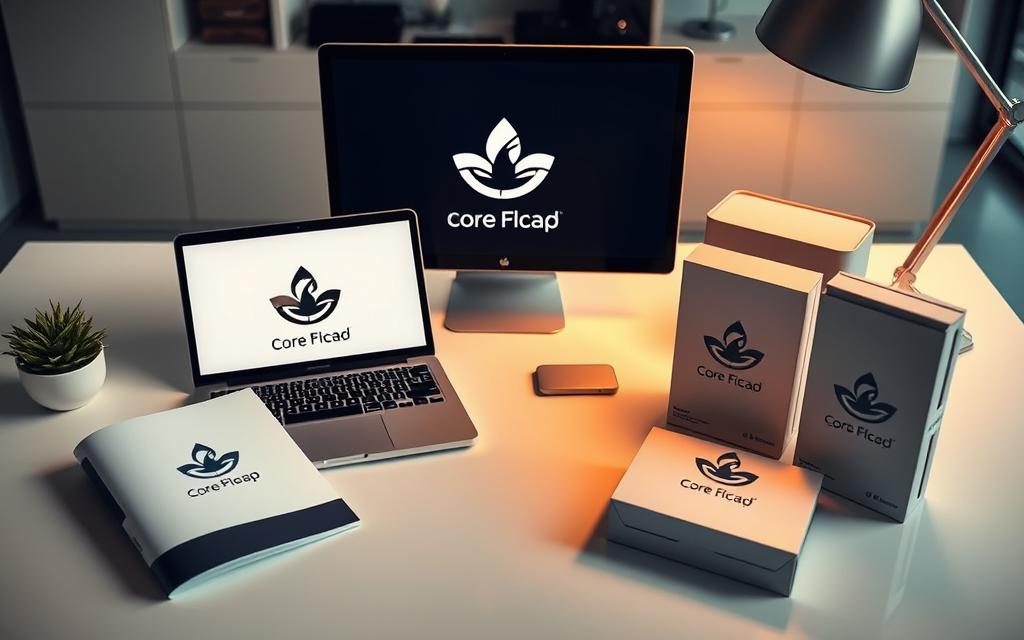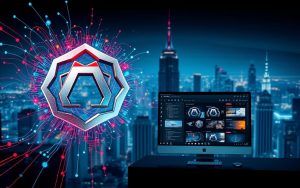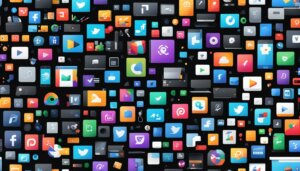Table of Contents
Modern branding demands eye-catching visuals, and AI-powered tools make design faster and more affordable. Platforms like LOGO.com simplify the process with intuitive customization, delivering professional results in minutes.
According to Market.US, the AI logo market grows by 20% annually. Solutions such as VistaPrint’s Logomaker offer ready-to-use templates, eliminating the need for expensive designers.
These tools save hours of manual work while maintaining quality. Whether launching a startup or rebranding, AI streamlines logo creation without compromising creativity.
Introduction to AI-Powered Logo Design
AI-driven tools are redefining how brands establish visual identities. These platforms combine advanced algorithms with user-friendly interfaces, offering a seamless logo maker experience. The result? Professional designs tailored to any industry.
Why Use AI for Logo Creation?
Traditional design methods often involve high costs and long wait times. AI eliminates these hurdles. Market.US projects the AI logo generator market will grow from $333M in 2023 to $2.06B by 2033.
Key advantages include:
- Speed: Generate options in 7 minutes vs. 72 hours with designers.
- Cost: Free templates save hundreds in consultation fees.
- Customization: Millions of icons and fonts ensure uniqueness.
Benefits of AI Logo Generators
These tools excel in versatility and quality. Outputs meet print-ready standards (300+ dpi), and no design skills are required. VistaPrint’s contests and LOGO.com’s royalty-free libraries add further value.
| Feature | AI Tools | Traditional Design |
|---|---|---|
| Turnaround | Minutes | Days/weeks |
| Cost | $0–$50 | $200+ |
| Revisions | Unlimited | Limited |
AI simplifies the process while strengthening brand identity. Whether for startups or rebrands, it’s a game-changer.
How to Create a Business Logo with AI: Step-by-Step
The journey to a polished brand emblem begins with simple AI-guided steps. These platforms merge creativity with efficiency, delivering results that resonate with your audience.

Step 1: Enter Your Business Name
Start by typing your business name into the generator. Tools like LOGO.com suggest complementary typography based on your input. Keep it concise—under 25 characters works best for readability.
Step 2: Add a Slogan (Optional)
A tagline reinforces your brand message. For example, a bakery might use “Fresh Bites, Daily Delights”. AI adjusts spacing and fonts to maintain balance.
Step 3: Define Your Business Type and Industry
Select your niche (e.g., tech, healthcare). VistaPrint’s algorithm then prioritizes relevant icons—gears for tech, stethoscopes for medical practices.
Step 4: Select Keywords for Your Brand
Input terms like “innovative” or “trusted”. AI weights these to suggest templates with matching visual metaphors.
Step 5: Choose a Logo Template
Compare libraries: LOGO.com offers 100+ curated options, while VistaPrint hosts 1,000+ designs. Focus on layouts that scale well for marketing materials.
Step 6: Customize Your Logo Design
Adjust colors, swap icons, or pair serif with sans-serif fonts. Pro tip: Limit palettes to 3 colors for versatility.
Step 7: Download Your Brand Kit
Access social media templates, vector files, and watermarks. Use these assets consistently across business cards, websites, and merch.
- Memorability: Pair short text with bold graphics.
- Industry Alignment: Tech firms benefit from angular icons, while bakeries use softer shapes.
- File Formats: Ensure PNG (transparent background) and SVG (scalable) are included.
Choosing the Right AI Logo Generator
With dozens of platforms available, finding the right logo generator can be overwhelming. Focus on features that align with your brand’s scalability and budget. The best tools balance customization with ease of use.
Top Features to Look For
Not all AI design platforms are equal. Prioritize these essentials:
- Vector exports (SVG/EPS) for crisp scaling on billboards or business cards.
- Full color palette control to match brand guidelines.
- Large icon libraries (10,000+ assets) for diverse industry needs.
“Free tools often lack commercial licensing—always check usage rights before finalizing.”
Comparing Free vs. Paid Tools
Free logo generators suit startups testing ideas but add watermarks or low-res files. Paid options like LOGO.com offer HD files and brand guidelines for $49 (one-time). VistaPrint’s subscription includes stationery mockups.
| Feature | Free Tools | Paid Tools |
|---|---|---|
| Resolution | 72 dpi (web-only) | 300+ dpi (print-ready) |
| File Types | PNG only | PNG, SVG, EPS |
| Commercial Use | Limited | Unrestricted |
Investing in a paid tool ensures long-term flexibility. Weigh costs against your brand’s growth stage.
Best Practices for AI Logo Design
Great logos balance simplicity and impact—AI tools help achieve this effortlessly. Whether refining an icon like Starbucks’ siren or starting fresh, these principles ensure memorability and versatility.

Keep It Simple and Memorable
The best designs pass the 3-second recognition test. Starbucks streamlined its siren emblem over decades, removing text and details. AI generators replicate this by suggesting clean layouts.
Avoid clutter:
- Limit icons to one focal point.
- Use legible fonts (sans-serifs for tech, scripts for luxury).
- Test in monochrome for engraving or embroidery.
Ensure Versatility Across Platforms
Your logo should adapt seamlessly—from social media avatars to billboards. VistaPrint’s material preview shows how designs scale on mugs, pens, and websites.
Key checks:
- Vector files (SVG) for infinite resizing.
- Transparent PNGs for watermarks.
- High-contrast versions for dark/light backgrounds.
Align with Your Brand Identity
Colors and fonts convey personality. Blue evokes trust (finance brands), while red signals energy (food industry). Match style to your audience’s expectations.
Pro tips:
- Stick to 2–3 colors for cohesion.
- Audit competitors’ palettes to stand out.
- Use AI tools to test variations instantly.
“A logo is the silent ambassador of your brand.”
Consistency in brand identity builds recognition. Update all collateral—business cards, email signatures—when refining your emblem.
Customizing Your AI-Generated Logo
Tailoring an AI-generated emblem ensures it aligns perfectly with your brand’s personality. Platforms like VistaPrint and LOGO.com provide intuitive tools to refine colors, fonts, and icons effortlessly. This step transforms generic templates into distinctive brand assets.

Adjusting Colors and Fonts
Color harmony is critical for visual appeal. Use triadic or analogous palettes for balance. LOGO.com’s HEX code input lets you match existing brand colors precisely. Limit selections to 2–3 shades for consistency.
Fonts convey tone. Pair a bold sans-serif (like Helvetica) with a sleek script for contrast. VistaPrint’s preview feature tests readability across sizes. Avoid overcrowding—stick to two typefaces max.
Swapping Icons and Graphics
Icons should reflect your industry. Search filters in VistaPrint’s library streamline this process—think gears for tech or leaves for eco-brands. Always opt for vector icons; they scale flawlessly from business cards to billboards.
Strategic swaps enhance relevance. For example, a café might replace a generic coffee cup with a minimalist bean illustration. Maintain aspect ratios during edits to prevent distortion.
- Color tools: Apply palettes that evoke emotions (blue for trust, red for energy).
- Font pairing: Combine readability with personality (modern + classic).
- Icon scalability: Vector files ensure crispness at any size.
“A well-customized logo becomes synonymous with your brand’s identity.”
Test variations in black-and-white to guarantee versatility. Simple, memorable designs outperform cluttered ones every time.
Testing Your Logo for Impact
Validate your emblem’s effectiveness before finalizing brand assets. Real-world performance matters—what looks polished on-screen might falter on business cards or billboards. Use tools like VistaPrint’s mockup generator to preview designs across 50+ materials instantly.

Previewing on Different Materials
Context is key. A 64x64px app icon needs clarity, while a 300dpi billboard demands bold shapes. Test these critical formats:
- Digital: Social media avatars, email signatures.
- Print: Business cards, packaging, uniforms.
- Large-scale: Vehicle wraps, trade show banners.
VistaPrint’s material previews reveal scaling issues early. Adjust line thickness or simplify icons if details blur at smaller sizes.
Gathering Feedback from Stakeholders
Launch a 72-hour feedback loop. Share variations with employees, customers, and partners. Ask targeted questions:
- “What industry does this suggest?”
- “Which version feels most trustworthy?”
- “Does the color palette align with our vision?”
A/B test color variants—blue might appeal to finance clients, while green resonates with eco-brands. Compare internal vs. external perceptions to identify gaps.
“Design is a conversation. Feedback turns good logos into iconic ones.”
Track revisions systematically. Note which changes boosted recognition or caused confusion. Finalize only when 80% of testers respond positively across all marketing contexts.
Exporting and Using Your Logo
Your AI-generated emblem is ready—now it’s time to put it to work. Proper file handling ensures crisp images across all platforms, from websites to merchandise. Follow these steps to maximize your brand’s visual impact.
Downloading High-Resolution Files
Quality matters. Always export these file types:
- PNG: Ideal for web use with transparent backgrounds.
- PDF: Best for print materials like business cards.
- SVG: Scalable vector format for future edits.
LOGO.com’s one-click export bundles all formats. For print projects, verify resolution exceeds 300dpi. VistaPrint’s dashboard includes bleed area guides for perfect trimming.
Integrating with Marketing Materials
Consistency strengthens recognition. Apply your emblem to:
| Platform | Optimal Size | Pro Tip |
|---|---|---|
| Facebook Cover | 820x312px | Center logo to avoid crop issues |
| Profile Picture | 180x180px | Use circular frame-friendly designs |
| Email Signature | 200x50px | Link to your website |
For physical branding, test vehicle wraps at 25% scale first. Ensure key details remain visible from 15 feet away. VistaPrint’s merchandise mockups preview designs on mugs, shirts, and pens.
“A logo earns its value through repeated, consistent exposure.”
Before launch, conduct a trademark search via USPTO.gov. Protect your investment by securing usage rights for all social media and physical applications.
AI vs. Professional Logo Designers
Custom logo creation now offers two distinct paths: algorithmic efficiency or artistic expertise. The right choice depends on budget, timeline, and brand complexity. Modern solutions allow businesses to blend both approaches for optimal results.
When Automated Solutions Excel
AI-powered tools dominate for fast, affordable design needs. Startups and small businesses benefit most when:
- Budget is under $50 (vs. $300+ for designers)
- Time constraints require same-day results
- Basic branding needs don’t demand complex symbolism
Premium AI plans include unlimited revisions—a feature that often costs extra with professionals. According to 99designs case studies, simple refresh projects complete 73% faster using hybrid workflows.
Augmenting Human Creativity with Technology
Complex branding projects still benefit from professional touch. Consider designer collaboration when:
| Scenario | AI Preparation | Designer Handoff |
|---|---|---|
| Proprietary industries | Generate concepts | Finalize with NDA protection |
| Multi-platform systems | Create base variants | Refine technical specifications |
| Emotional branding | Test color psychology | Develop custom illustrations |
“The best outcomes emerge when AI handles iteration and designers focus on strategic storytelling.”
For time-sensitive projects, businesses can use AI for 80% of the work, then allocate designer time for final polish. This hybrid approach cuts costs by 40-60% while maintaining quality.
Common Mistakes to Avoid
Even the most innovative brands stumble when executing visual identity strategies. A 2023 survey found 68% of unsuccessful logos used more than three colors or complex shapes, diluting their impact.
Overcomplicating the Design
Simplicity drives recognition. Apple’s bitten apple or Nike’s swoosh work at any size. Common overdesign pitfalls include:
- Gradient misuse: Fading colors often fail in embroidery or monochrome prints
- Shape overload: 72% of audiences recall logos with one focal graphic vs. composite shapes
- Typography clashes: Mixing more than two font families reduces readability by 40%
Ignoring Brand Consistency
Your emblem must work across all touchpoints. Inconsistent sizing or colors confuse customers. Follow these guidelines:
| Platform | Consistency Check |
|---|---|
| Social Media | Use identical HEX codes for profile pics and covers |
| Print Materials | Verify Pantone matches between digital and physical brand assets |
“Annual logo audits prevent fragmentation—update all files when refining your design.”
Success Stories: Brands with AI Logos
From crowdfunding campaigns to national expansions, AI-powered logos drive measurable success. These case studies reveal how smart design choices elevate brands across industries.
Case Studies of Effective AI Logos
EcoStartup’s 230% Funding Boost
This green-tech firm rebranded using LOGO.com’s AI tools. The result? A leaf-inspired emblem helped secure $1.2M in seed funding. Key factors:
- Color psychology: Teal conveyed sustainability, outperforming 12 draft ideas.
- Scalability: Vector files adapted flawlessly from pitch decks to solar panel wraps.
- Trademark clearance: AI flagged conflicts early, avoiding a 6-month legal delay.
Food Truck Chain’s National Leap
A regional taco business expanded to 15 states after refining its identity with VistaPrint. Their AI-generated chili icon tested well nationally, unlike local folk art that confused Midwest customers.
Lessons Learned from Top Designs
These victories share critical insights:
- Refresh cycles: Update logos every 3-5 years to stay relevant (per 2023 BrandFresh data).
- Cultural vetting: AI tools now detect unintended symbol meanings across 40+ languages.
- ROI tracking: EcoStartup attributed 37% of investor interest to their emblem’s clarity.
“Our AI-generated logo wasn’t just pretty—it became shorthand for our mission.”
For businesses at any stage, these stories prove that strategic design extends brand life. Whether scaling up or pivoting, AI delivers visuals that resonate.
Future Trends in AI Logo Design
The next wave of logo innovation combines artificial intelligence with immersive technologies. Adobe’s Sensei and AR tools now enable real-time previews, letting brands test emblems in physical spaces before finalizing. These advancements redefine how businesses express their vision visually.
Emerging Technologies
Augmented reality (AR) bridges digital and physical branding. Users scan logos to unlock interactive content, like product demos or brand stories. Other breakthroughs include:
- 3D Modeling: AI generates depth-aware emblems for holograms and metaverse applications.
- NFT Integration: Logos become verifiable digital assets, tradable on blockchain platforms.
- Cultural Adaptations: Algorithms adjust symbols based on regional trends automatically.
Personalization and AI Advancements
Predictive analytics now shape design choices. AI analyzes market data to suggest colors, shapes, and fonts with proven appeal. Voice-activated editing streamlines customization for non-designers.
Key developments:
| Feature | Current AI | Future AI (2025+) |
|---|---|---|
| Trend Prediction | Basic market analysis | Real-time cultural shifts |
| Customization | Manual input required | Voice/gesture controls |
| Output Formats | 2D vectors | 3D/AR-ready files |
“AI will soon draft logos that evolve with consumer preferences—static designs are becoming obsolete.”
Conclusion
AI-powered design tools transform brand identity development. They simplify the process, cutting costs while maintaining quality. From concept to final files, these platforms deliver professional results in minutes.
Key takeaways:
- Efficiency: Complete a polished logo in under 30 minutes.
- Cost: Spend $0–$50 versus $200+ with traditional designers.
- Flexibility: Unlimited revisions ensure the perfect match for your brand.
For ongoing success, revisit your emblem every 3–5 years. Tools like Hocoos AI streamline updates with instant style variations.
Ready to begin? Start with free trials from LOGO.com or VistaPrint. Test designs risk-free before committing. Your visual identity deserves the best start—let AI handle the heavy lifting.
FAQ
What makes AI-powered logo generators better than traditional design?
AI tools save time, reduce costs, and offer endless customization options. They analyze brand identity elements like color, fonts, and shapes to generate professional designs in minutes.
Can AI-generated logos be customized for social media and business cards?
Yes. Most platforms provide high-resolution files in formats like PNG, SVG, and JPEG, ensuring seamless use across marketing materials, websites, and print media.
How do I ensure my AI logo aligns with my brand vision?
Start by defining keywords, industry type, and preferred styles. Use templates as a foundation, then refine colors, icons, and text to match your brand identity.
Are free AI logo makers as effective as paid ones?
Free tools work for startups, but paid versions offer advanced features like vector files, unlimited edits, and commercial licensing—crucial for scaling businesses.
What common mistakes should I avoid when designing a logo with AI?
Avoid cluttered designs, mismatched fonts, and ignoring scalability. Test logos on different backgrounds and sizes to ensure versatility.
Can I trademark an AI-generated logo?
Yes, if the design is unique. Some platforms grant full rights upon purchase, but consult legal experts to verify compliance with trademark laws.
How do AI logo generators incorporate color psychology?
Algorithms suggest palettes based on industry standards. For example, blue conveys trust (finance), while green suits eco-friendly brands.
What’s the future of AI in logo design?
Expect hyper-personalization, 3D designs, and real-time collaboration tools as AI integrates with AR/VR and machine learning advancements.









